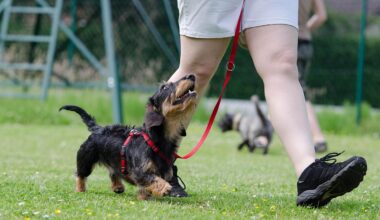Case Studies: Successfully Overcoming Dominance Challenges
Dominance-related behavior in dogs can manifest in various troubling ways. Owners often find themselves dealing with aggression, possessiveness, and even refusal to obey commands. Understanding these behaviors is crucial for developing effective training strategies. In this article, we will explore real-life case studies where effective intervention techniques turned challenging canine behaviors into positive outcomes. Each case provides unique insights into the intricacies of dog training. By understanding the underlying psychology of the dog, owners can make informed decisions. Utilizing positive reinforcement is a significant aspect of overcoming dominance issues. Although it may take time, consistent effort can lead to improved relationships with beloved pets.
In our first case study, we meet Max, a German Shepherd exhibiting aggressive behavior towards strangers. His family was fearful of how other people interacted with him. The owner sought professional help, adopting a training regimen that emphasized desensitization. The trainer, using treats and praise, taught Max to remain calm while exposed to new individuals. This gradual approach helped shift Max’s perception from defensiveness to trust. Over weeks of training, he learned the value of positive interactions with unfamiliar faces. The family described a new Max: relaxed and tolerant in social settings, signifying the effectiveness of proper behavioral modification techniques.
Next, we delve into Bella, a Labrador mix who displayed possessive tendencies over her toys and food. Bella’s owners found it increasingly difficult to manage her behavior, leading them to fear resource guarding incidents. Engaging a canine behaviorist, they implemented a strategy around the “trade game”. This allowed Bella to learn that relinquishing her items could lead to receiving something even better. By gradually increasing the value of the items traded, Bella experienced the joys of sharing. The result was a more relaxed and open-minded dog. This case emphasizes the importance of structure and patience in modifying dominance-related behavior.
Understanding Dominance in Dog Behavior
Another compelling example involves Rocky, an assertive Rottweiler. He frequently attempted to dominate his owner’s space, leading to tensions. The owner felt overwhelmed and uncertain on how to reestablish boundaries. After consultation with a dog trainer, they began to reinforce commands that emphasized structure and consistency during interactions. Simple commands, like “sit” and “stay”, gradually shaped Rocky’s understanding of submission. Instead of battling for control, the owner learned to assert gentle authority consistently. This approach significantly improved their relationship. Through patience, Rocky became receptive to guidance, unlocking his potential as a wonderful and well-mannered companion.
Further along, we explore the case of Sophie, a Border Collie who notoriously struggled with leash reactivity. Her dominant behavior created difficulties during walks, much to her owner’s dismay. In seeking solutions, they embarked on a training program focusing on controlled exposure techniques. Buddy system walks with calmer dogs made a substantial difference for Sophie. Over time, she learned to focus on her owner rather than becoming easily distracted by the environment. This case highlights how patience, gradual desensitization, structured exposure, and positive reinforcement can lead to remarkable improvements in walking behavior among dogs with dominance-related challenges.
In a final case, we have Duke, a young Pitbull displaying aggressive protection behaviors. His owners struggled with Duke’s overzealous guarding instincts, which often escalated to growling at visitors. The intervention involved the gradual introduction of guests into Duke’s space, reinforcing good behavior with treats. Encouraging calm greetings and focusing on obedience commands brought measurable changes. The key was perseverance and building Duke’s trust through exposure. He began welcoming visitors with wagging tails instead of fear and aggression. This experience demonstrates that with patience, understanding dog behavior, and employing the right techniques, behavioral problems associated with dominance can transform into positive experiences.
Key Takeaways from the Case Studies
These case studies underscore crucial methods for managing dominance-related dog behaviors. Positive reinforcement emerges as a pivotal strategy, reinforcing good behavior over time. Consistency in training sessions helps build trust between dogs and owners, allowing for a stronger bond. Gradual desensitization to triggers plays an instrumental role in overcoming negative responses. Each case showcased the importance of professional advice and tailored methodologies specific to each dog’s needs. Owners must dedicate time and effort to see meaningful change. With proper guidance and commitment, any dog exhibiting dominance challenges can live harmoniously within their household, demonstrating that love and patience are essential.
Conclusion: Dominance-related behavior does not have to be a permanent state for dogs. As highlighted in these case studies, proactive engagement and proper training techniques create a pathway toward improvement. Building a healthy relationship centered on trust, positive reinforcement, and structure yields remarkable results. The key is determination, understanding, and the willingness to adjust training methods where needed. By learning from successful case studies, owners can navigate the complexities of dog behavior with confidence. By recognizing potential issues early and addressing them appropriately, harmony can flourish. Dogs, like all living beings, are capable of change when guided with care and compassion.


